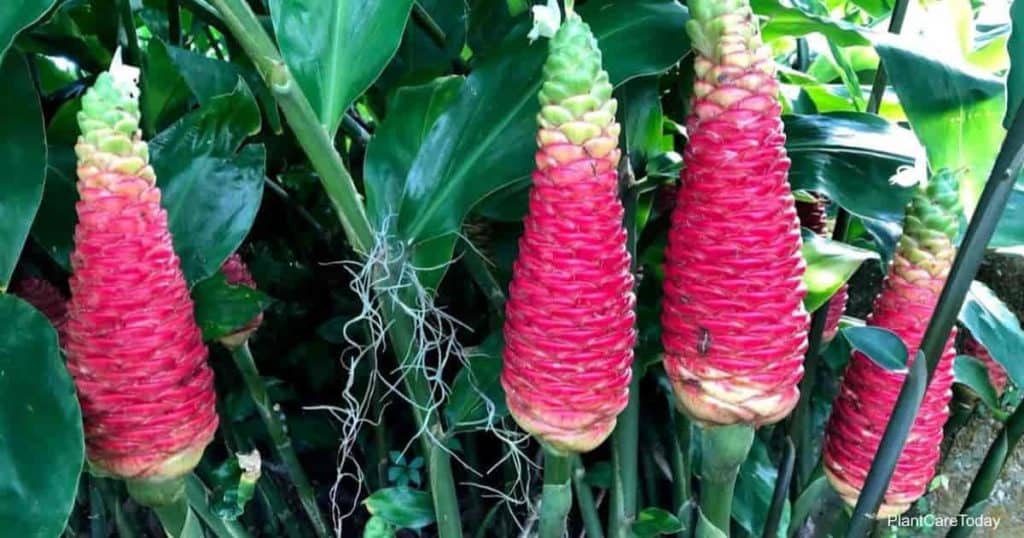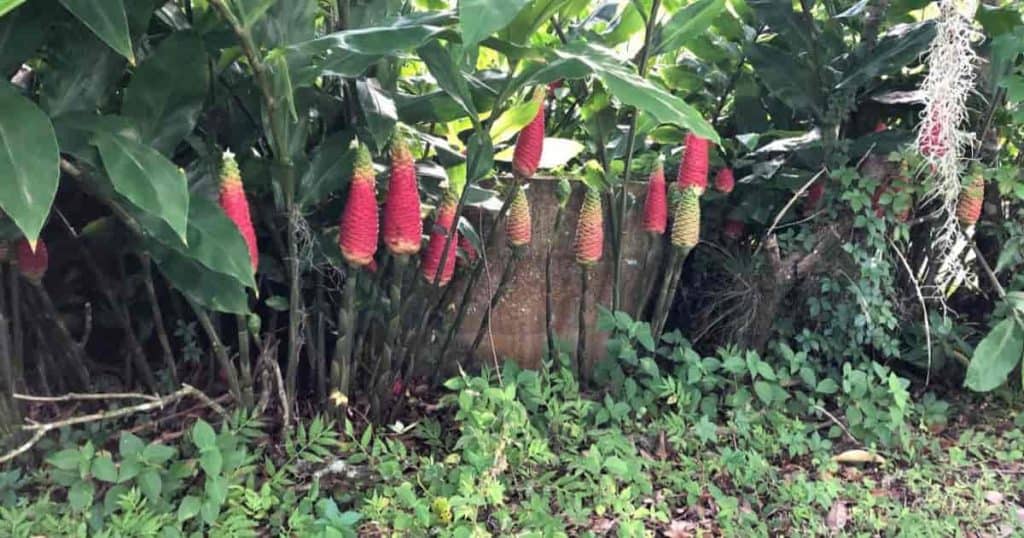“Shampoo flower gets its various names from its pinecone-shaped inflorescence. When squeezed, the flower produces a fragrant milky-white substance and is used as a shampoo or hair conditioner.“
What is Shampoo ginger? The Shampoo ginger lily – Zingiber Zerumbet is an aromatic, clumping perennial. It comes from the large ginger Zingiber genus of the family Zingiberaceae. The ginger shampoo plant is an important monocot plant of order Zingiberales.

Other popular ginger plant family members include:
- Alpinia Zerumbet variegata (Variegated Shell ginger)
- Ginger (Zingiber officinale)
- Turmeric(Curcuma longa)
- White Ginger Lily (Hedychium coronarium)
- Grains of Paradise (Aframomum melegueta)
Its botanical name is Zingiber zerumbet [zing-ee-ber, ZER-um-bet] (L.) Smith.
Zingiber is a Sanskrit word meaning a bull’s horn. This hints at the horn-like appendage attached to its stamen.
Other common names include:
- Bitter ginger
- Pinecone ginger
- Shampoo ginger
- Shampoo lily
- Pinecone lily
- Wild ginger
- Awapuhi kuahiwi (in Hawaii)
- Lampoyang (in Malaysia and Indonesia)
Zingiber Zerumbet Quick Plant Care Tips
- Botanical Tips: Botanical Name: Zingiber Zerumbet
- Common Name(s): Shampoo Ginger, Pinecone Ginger, Awapuhi
- Synonyms: Zingiber Zerumbet Smith, Zingiber Zerumbet Roscoe
- Family & Origin: Zingiberaceae family, native to Southeast Asia
- Growability: Easy to grow
- Grow Zone: USDA zones 8-10
- Size: Grows up to 4′ feet tall
- Flowering: Produces cone-shaped flowers that resemble pinecones
- Light: Prefers partial shade to full shade
- Humidity: Tolerates low humidity levels
- Temperature: Thrives in warm temperatures between 60-80°F
- Soil: Well-draining soil with organic matter
- Water: Keep soil consistently moist but not waterlogged
- Fertilizer: Feed with a balanced fertilizer every 2-3 months during the growing season
- Pests & Diseases: Susceptible to spider mites and mealybugs. Watch for root rot if the soil is too wet.
- Propagation: Propagated through division of rhizomes or by seed
- Plant Uses: Used for medicinal purposes, as a culinary spice, and as an ornamental plant in gardens and floral arrangements.
The pinecone ginger is a rhizomatous herbaceous plant found in tropical Asia. The exact origin is unknown.
Many believe it to be native to the Indian Subcontinent and Malaysian Peninsula. From there, it spread to Southeast Asia, the Pacific Islands, and Thailand by Polynesian settlers.
Shampoo ginger Zingiber Zerumbet is also grown in various parts of Hawaii. Also known as Amomum zerumbet L., this tuberous root herb plant is grown as an ornamental and medicinal plant.
Lily shampoo ginger plant grows best in damp areas with partial shade and humid conditions. It is found around wet roadsides, shady lowlands, streams and river banks, and hill slopes.
‘Wild’ pinecone ginger or bitter ginger got its name from its use as a culinary additive with a bitter taste.
Shampoo Ginger Lily Plant Care
Size & Growth
With a clumping growth habit, Zingiber Zerumbet usually grows about 4’ feet tall, however, in some cases, it is found to grow up to 6′ to 7’ feet tall.

Its reed-like, erect stems rise up to 4’ feet and are clumped by sheaths of 8” inches-long, narrow leaves.
The inflorescence grows 2” to 4” inches in length.
Shampoo Lily Flower and Fragrance
Aromaticum is a broad-leaved plant that produces showy blooms on flower stalks from August to September.
In spring, 9 to 12 blade-like green leaves appear on the underground stem.
By mid to late summer, the thick ginger shampoo plant rhizomes produce flower spikes, each topped with a globular, brightly colored inflorescence.
The inflorescence resembles a pinecone and is initially wrapped by green, waxy bracts, which turn a vibrant shade of red upon reaching maturity.
The red pine cones have a fresh, aromatic, ginger-like scent.
The pinecone-shaped inflorescence produces tiny tri-petaled flowers in hues of yellow and is full of fresh-smelling, bitter-tasting, creamy white sap.
Shampoo Plant Light & Temperature
Bitter ginger is winter hardy to the USDA hardiness zones 8 through 10.
The awapuhi plant prefers tropical or subtropical climates but also grows in mild climates on the mainland.
In colder climates, the pinecone ginger plant is grown indoors. When growing outdoors in Central Florida, the pinecone ginger begins to die back as the weather changes.
The ideal temperature for these exotic plants is 32° degrees Fahrenheit (0° C) or higher.
These perennials enjoy full sun to part shade.

Watering and Feeding
Shampoo ginger should be seasonally waterlogged.
Water them with free-draining soils during the warmer months and keep them dry during the dormant winter months.
Similarly, fertilize shampoo lily ginger plants with an all-purpose fertilizer during summer only.
Supply phosphorus-rich fertilizer by the end of the growing season to ensure healthy and well-grown rhizomes.
Soil & Transplanting
Pine cone ginger thrives in filtered shade and rich soil.
It prefers soil with a neutral pH and a light to medium texture.
In summer, provide the plant with consistently moist soils and keep the soil dry during winters since the plant goes dormant and requires less moisture.

While the shampoo plant shows great tolerance for poor sandy soil, hard soils need to be adjusted by adding gypsum before planting the plant.
Wild ginger is cultivated by seeds and underground rhizome extract.
Harvest new Zingiber rhizomes 10-12 months after planting. Transplant in late winter or early spring.
Grooming and Maintenance
Shampoo ginger lily is a forgiving and fast-growing perennial that can spread across a garden within years under ideal conditions.
For a beginner, a ginger shampoo plant care would be easy to meet.
In USDA Zone 8, these plants survive winter when mulch is added to the soil and the roots and rhizomes are protected from freezing.
However, in regions located north of Zone 8 up to Zone 10, the rhizomes should be picked up and overwintered indoors.
Also, potted plants should be kept indoors, away from the frost, when temperatures fall below 55° degrees Fahrenheit (13° C).
Snip the leaves which die to the ground after the first frost.
Keep an eye out for pests and, if infested, spray with a strong water jet and apply plant-based horticulture oil on the leaves.
Do not apply oils when the climate is hot and humid.

How To Propagate Shampoo Ginger Plant
You don’t need to be an expert to know how to grow shampoo ginger lily plants.
There are 2 popular methods to plant ginger lily, using store-bought plants, seeds, or roots.
Using roots is preferred by many, so let’s start learning how to propagate Awapuhi plants through their rhizomes.
How To Grow Shampoo Ginger Lily by Roots (Rhizomes)
- A clump of thick, juicy, bitter ginger with multiple buds should be used for this purpose.
- Wear gloves and use a sharp knife to cut the rhizomes into pieces.
- Each piece should consist of several buds.
- Keep the pieces for a few days until the cuts are dry.
- Next, soak the pieces of rhizomes overnight in a container filled with warm water.
- Take equal parts of potting soil and compost in a 5-gallon container and mix the ingredients until a rich, moist mixture is obtained.
- Fill the pot with this mixture and plant a couple of pieces half-inch deep in the soil with the buds facing upwards.
- Keep the plant indoors in a warm, sheltered place with filtered light.
- In colder regions, place it under full sun.
- Water the plant whenever the upper surface of the soil feels dry to the touch.
- Supply organic fertilizer twice a week until the rhizomes have sprouted.
How To Grow Shampoo Ginger Lily by Seeds
- Soak seeds in warm water for 24 hours to soften the seed coat.
- Plant the soaked seeds 1/4 inch deep in a well-draining potting mix in seed trays or pots.
- Place trays in a warm, humid area with indirect light at 75-85°F (24-29°C). Germination may take weeks to months.
- Move seedlings with several leaves to larger containers or the garden once they are sturdy.
- Maintain consistently moist soil without waterlogging. Provide filtered light and shield from strong winds and cold temperatures.

Pest Or Disease Problems For The Shampoo Ginger Plant
A healthy-growing shampoo ginger plant is mostly free from any serious pest or disease problem.
However, sometimes aphids and mites attack the young, tender growth.
It also occasionally hosts spiraled whitefly, Aleurodicus disperse, and cardamom root grub, Basilepta fulvicornis.
Is Bitter Ginger Toxic or Poisonous?
Bitter ginger is an edible plant and has medicinal uses.
It is not poisonous.
It contains a wide range of chemical compounds like polyphenols, terpenes, and zerumbone.
It also contains flavonoids.
Is The Pinecone Ginger Plant Invasive?
The plant is not considered a high-risk invasive species but is sometimes deemed invasive when people grow shampoo ginger outside its native range.
However, it spreads at a rapid pace and has the potential to restrict the spread of other plants if provided limited space.
Suggested Zingiber Zerumbet Uses
Landscaping
Red pinecone ginger serves the purpose of an exotic landscape accent due to its bright green foliage and flamboyant red cone-like inflorescences.

They make a beautiful floral arrangement when used as cut flowers and are used as ornamental plants.
Knowing where and when to plant shampoo, ginger, or any other plant is a great skill to have.
Therapeutic Properties
- It has been used for traditional medicines since ancient times and is associated with Southeast Asian ginger sesquiterpene, cancer cell proliferation, free radical generation, and protein production.
- This plant is known and used widely for its anti-inflammatory activity.
- It has also exhibited antioxidant, antidiabetic, anticancer, analgesic, antiviral, and antimicrobial activity.
- Its traditional uses include the treatment of a myriad of conditions like stomach aches, diarrhea, sprains, toothaches, and even cancer.
Due to this, recent studies have established a number of pharmacological uses for zingiber zerumbet smith.
Note: Every situation is unique. Always consult your doctor before using medicinal herbs, as they can either help or harm your condition. Your health is too important to take chances.
Other Uses
The leaves of the plant are used as a food additive and wrapping material.
The slippery sap extracted from the ginger lily rhizomes is used to make ginger lily shampoo, hair conditioners, essential oils, and perfumes.
